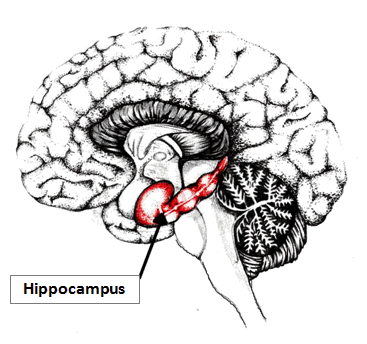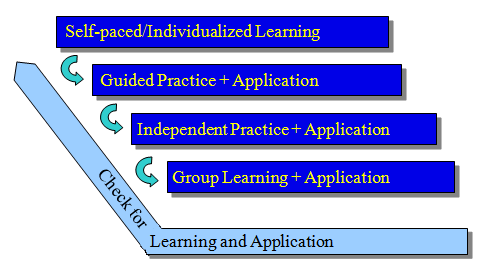|
Section
4: Applying Cognition Memory Theory to DL

Human learning is often case-based, rather than
rule-based according to cognitivists. From this view, learning
is the dynamic modification of memory. During a learning process,
memory is changed by each use, each experiment with cases.
Cognitive Load Theory
Schema
Information processing in long-term memory is
made through schema which is a cognitive structure that allows
multiple elements of information to be categorized as a single
element. Examples of schema structure based on the complexity
level of information are:
- Level 1: alphabet recognition
- Level 2: word recognition
- Level 3: sentence recognition
- Level 4: contextual recognition
- Level 5: thematic recognition
Types of schematic information includes:
- Pictorial
- Verbal
- Written
- Auditory
- Olfactory (sense of smell)
- Tactual
Conscious vs. Automatic Memory Process
- Conscious memory process requires a
person's attention and intentional process of information
for understanding (explicit memory).
- In automatic memory process long-term
memory is processed without conscious control (as we can read
books without consciously considering words and combination
of words) (implicit memory).
Types of Memory
Three major types of memory are illustrated here
to understand how learned information and knowledge are accumulated
in our brain.
- Working memory can handle only limited
number of information (7+2).
- Short-term memory refers to the amount
or bits of information we can hold in our head at any given
time and lasts between 10 to 15 seconds.�Some researchers
differentiate short-term memory from sensory memory which
is detected by the sensory receptors that are retained temporarily
in the sensory registers.
- Intermediate memory occurs once the
information has been processed. It can be viewed as the part
of memory which holds and mixes information from the different
parts of memory. This will determine how we feel and what
we will do about a given situation. It defines our ability
to express actions.
Long-term memory resides in the deep unconscious
and can be viewed as the "repository" of all our knowledge.
It is divided into four parts: episodic, semantic, priming,
and procedural memory.
- Episodic memory
is experience based. This would include memories of events
and experiences. It is enhanced by sensory input such as sights,
sounds, music, smells and touch.
- Semantic memory
would include remembering specific information such as math,
names, facts, and figures.
- Priming memory
is a nonconscious form of human memory which is concerned
with perceptual identification of words and objects.
- Procedural memory
is hands on learning. When we learn a skill such as riding
a bike or playing a sport, motor memory is necessary. These
skills can only be learned by physically doing them. It is
automatic memory.
Figure: Structure and Types of Memory

Working Memory Limitation
In instructional design, considering working memory
limit is critical aspect to decide appropriate instructional
strategies. Human beings have limited capabilities of processing
working memory. Due to this, we have to design instruction to
reduce extraneous load and redirect learners' attention to cognitive
processes that are directly relevant to the schemas construction.
The following types of cognitive load can limit or facilitate
learners' cognitive processing.
- Intrinsic cognitive load - This is a
type of cognitive load occurring due to the natural complexity
of the information that is processed. The cognitive load is
determined by the levels of element interactivity (e.g., translating
one word to another language vs. understanding a phrase in
foreign language requires different cognitive load).
- Extraneous cognitive load - This happens
when we ignore working memory limits and fail to focus working
memory resources on schema construction and automation.
- Germane cognitive load - This is effective
cognitive load caused by effortful learning resulting in schema
construction and automation through examples and demonstration.
Functions of Brain
In memory processing, the following diagram illustrates
which part of brain processes what kind of information.

- Frontal lobe
- helps control skilled muscle movements, mood, planning for
the future, setting goals and judging priorities.
- Parietal lobe
- receives and processes information about temperature, taste,
touch, and movement. Reading and arithmetic are also processed
in this region.
- Temporal lobe
- processes hearing, memory and language functions.
- Occipital lobe
- helps process visual information.
- Medulla oblongata
- contains centers for the control of vital processes such
as heart rate, respiration, blood pressure, and swallowing.
- Pons -
the coordination of eye movements and balance.
Hippocampus
Hippocampus is the central part of human brain
functioning the following tasks.

- Stores and processes memories
- Helps find memories
- Affects emotions
Strategies for Improving Cognitive Learning
for Distance Learning
Improving Cognitive Processes for Learning
Several cognitive strategies can be utilized to
improve cognitive processing during learning.
- Worked example effect - This method
is to reduce cognitive load by providing worked examples during
learning.
- Split-attention effect - For cognitive
focusing, attention must be split between multiple sources
of information to understand the whole content (understand
each segment of swing motion to make a full golf swing).
- Modality effect - This method recommends
the use of multiple information sources and perceptual methods
to improve memory process (use verbal explanation and visual
graphics to teach how to swing).
- The redundancy effect - This method
is utilizes reiteration to augment and reinforce learning
(repetition through lecture and review sessions).
Applying Cognitive Learning Theory to Distance
Learning Framework
In planning and developing a distance learning
program, establishing a cognitive learning framework is a very
useful tool to incorporate the above mentioned principles in
designing the instruction. An example cognitive learning framework
will look like this:

A good example of this learning framework can
be found from this course structure. To improve your distance
learning experience, the instructor designed this course utilizing
the following guidelines:
Self-paced and individualized
learning phase
Learner studies the course content according to the learner's
own learning speed and competency level.
Group learning phase
Learner interacts with other peer students and/or tutors to
augment learning experience and accumulate group knowledge.
Learning application
phase
Learner applies his/her own learning to actual events or works
to internalize the required competency.
Learning and transfer
evaluation phase
Evaluate the learning before, during, and right after a course.
Evaluate the application of learning during the course and transfer
of learning 3 or 6 months after the course.
* Each phase of the framework of learning can
be processed either in a linear or mixed pattern according to
the intention of the learning experience of the instruction.
This is the end of learning module 3.
You have no assignment for this learning module.

|
Previous
|
|
|
|
|
